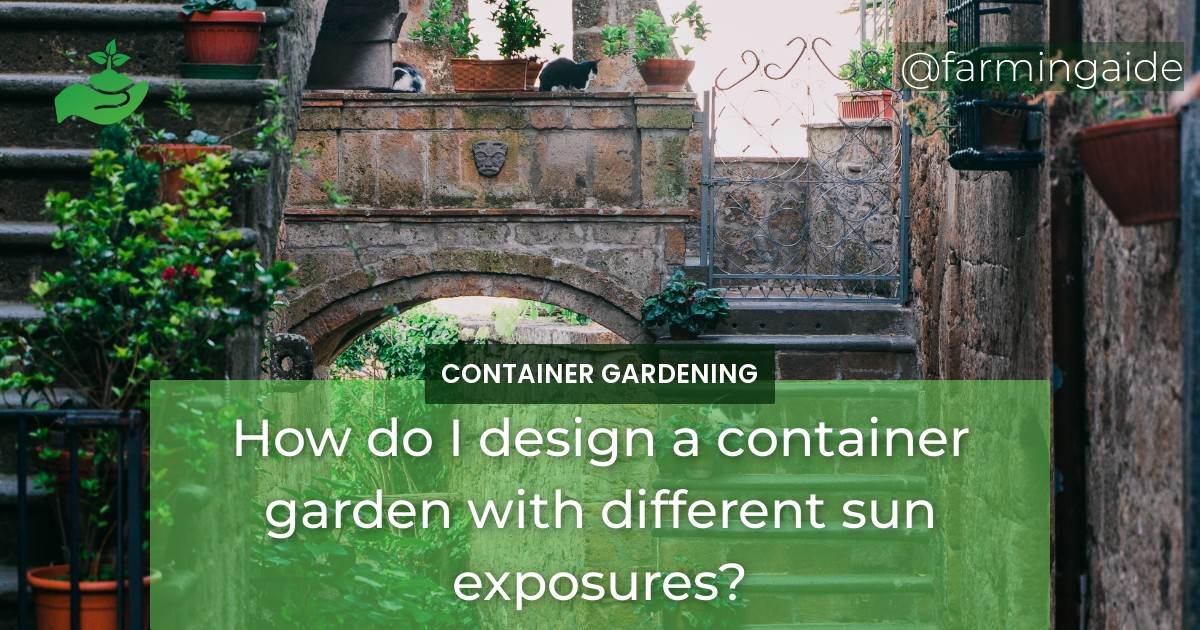Container gardening is an excellent way to have a garden in a small space or add some greenery to a balcony, patio, or rooftop. Designing a container garden with different sun exposures can be challenging, but it is possible with the right planning. The key to success is selecting plants that can thrive in the specific sun exposure and designing the container accordingly. This article will provide tips on how to design a container garden with different sun exposures, selecting plants for container gardening with different sun exposures, designing the container garden, and maintaining the garden.
Understanding Sun Exposure for Container Gardening
Importance of Sun Exposure in Container Gardening
The amount of sun exposure is critical when designing a container garden. Plants require different levels of sunlight to thrive, and too much or too little light can harm them. Full-sun plants need at least six hours of direct sunlight each day, while partial sun plants need two to four hours of direct sunlight, and shade plants require less than two hours of direct sunlight.
Types of Sun Exposure
Full Sun Exposure
Full sun exposure means six or more hours of direct sunlight per day. It is ideal for most flowering plants, tropical plants, and succulents. However, it is essential to note that some plants can handle full sun exposure, but their leaves can burn if exposed to too much direct sunlight.
Partial Sun Exposure
Partial sun exposure means two to four hours of direct sunlight per day. It is ideal for foliage plants and vegetables that require less sunlight. It is also suitable for plants that cannot tolerate too much direct sunlight.
Shade Exposure
Shade exposure means less than two hours of direct sunlight per day. The ideal plants for shade exposure are foliage plants and flowering plants that can thrive in low-light conditions.
Selecting Plants for Container Gardening with Different Sun Exposures
Plants for Full Sun Exposure
- Geraniums
- Petunias
- Marigolds
- Succulents
- Tomatoes
- Peppers
Plants for Partial Sun Exposure
- Impatiens
- Salvia
- Leafy greens
- Radishes
- Carrots
- Herbs
Plants for Shade Exposure
- Hostas
- Ferns
- Begonias
- Caladiums
- Violas
- Astilbes
ALSO READ
Designing Container Garden with Different Sun Exposures
Choosing Containers
When selecting containers for a container garden, it is essential to choose a container that is appropriate for the plant’s size and the sun exposure. Plants that require full sun exposure will need larger containers than those that require partial sun exposure. The container should also have drainage holes to prevent waterlogging.
Soil Selection
The soil used in container gardening should be high-quality, well-draining soil that is rich in organic matter. It should also be appropriate for the type of plant being grown and the sun exposure. Plants that require full sun exposure will need soil that retains moisture well, while those that require partial or shade exposure will need a soil that drains well to prevent root rot.
Container Placement
Container placement is crucial when designing a container garden. Containers that require full sun exposure should be placed in an area with direct sunlight for at least six hours per day. Containers that require partial or shade exposure should be placed in an area with less direct sunlight.
Arrangement of Plants
The arrangement of plants in a container garden is essential to ensure that they receive adequate sunlight and space to grow. It is best to group plants with similar sun exposure requirements in the same container. Also, plants that grow tall should be placed in the center or back of the container, while shorter plants should be placed in front or on the sides.
Tips for Maintaining Container Garden with Different Sun Exposures
Watering
Container gardens require regular watering, especially during hot weather. However, it is essential not to overwater the plants, as this can lead to root rot. The best way to determine if a plant needs watering is to check the soil’s moisture level. If the soil is dry, it is time to water the plant.
Fertilizing
Container gardens require regular fertilization to provide the plants with the necessary nutrients. It is best to use a slow-release fertilizer that will provide the plants with a steady supply of nutrients over time.
Pruning and Deadheading
Pruning and deadheading are essential to ensure that the plants remain healthy and blooming. Deadheading is the process of removing dead flowers, while pruning involves cutting back overgrown branches or stems. It is best to prune and deadhead plants regularly to promote healthy growth.
Pest and Disease Management
Container gardens are susceptible to pests and diseases, just like any other garden. It is best to inspect the plants regularly for signs of pests or disease and take action immediately. There are various organic pest and disease control methods that can be used to manage these problems.
ALSO READ
Conclusion
Designing a container garden with different sun exposures requires careful planning and selection of plants that can thrive in the specific sun exposure. It is essential to choose the right container, soil, and placement to ensure that the plants grow healthy and beautiful. Regular maintenance is also necessary to promote healthy growth and manage pests and diseases.
RELATED ARTICLES:


